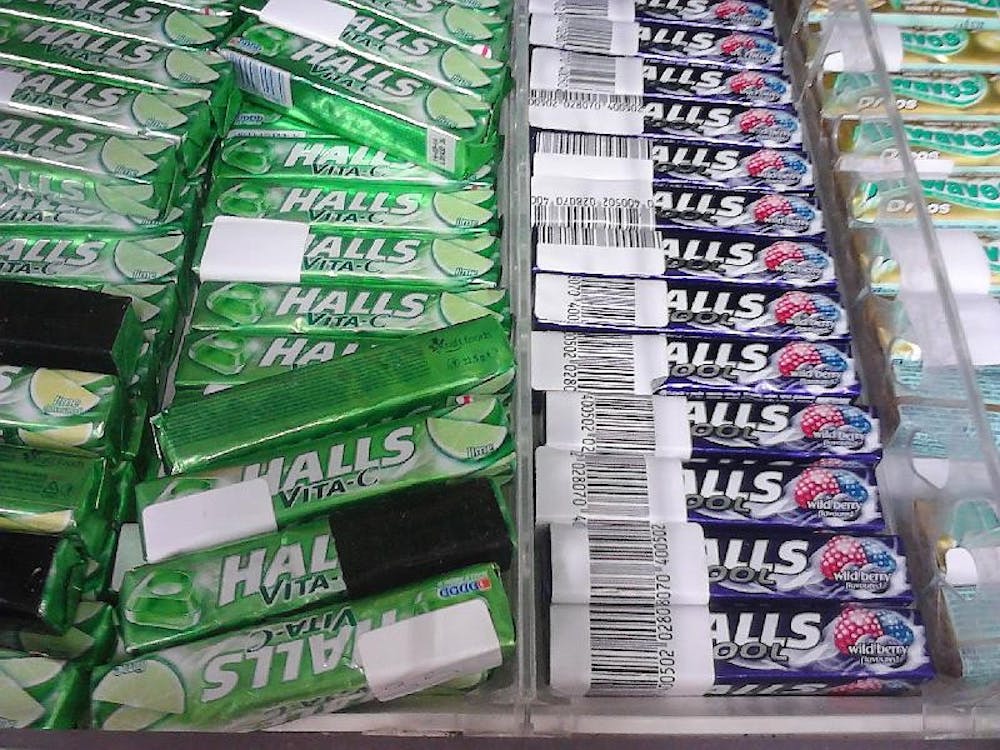
Along with tissues and flu medication, cough drops are just about everywhere during the winter months. They are a staple of cold and flu season and can be found in dozens of different flavors, sold by numerous different brands. At times they almost seem to straddle the boundary between candy and medicine. In fact, many early cough drop manufacturers began as candymakers, bakers or confectioners of some sort.
HALLS, though now populating the shelves at CharMar and many other stores across the U.S., began in Britain. The Hall brothers — Edwin Franklin, Thomas Harold and Norman Smith — started their business in 1893, originally as jam manufacturers. Edwin left the partnership in late 1902, but Thomas and Norman carried on, and their business eventually branched out to sell boiled sweets, caramels and other candies.
Mentho-Lyptus, as the name suggests, is a sweet containing both menthol and eucalyptus. It was introduced by the Hall brothers’ company in 1927. Meant to serve as a remedy for sore throats and as a cough suppressant, it provides a soothing, cooling sensation and can also act as an oral anesthetic. HALLS’ Mentho-Lyptus cough drops were introduced to the U.S. in the 1950s.
Prior to this, however, there were several well-known mass-manufactured brands of cough drops circulating in America. Among the most famous products were the Smith Brothers’ cough drops.
The company was led by brothers Andrew and William, but the idea originated with their father James, a candymaker in Poughkeepsie, N.Y.
As the story goes, in 1847 a peddler named Sly Hawkins sold James the recipe for a cough reliever. James used his confectioneering experience to refine it into a candy-like product. William and Andrew helped their father, eventually taking over the business after his death in 1866.
As a marketing strategy and in order to discourage the sale of imitations, the Smith brothers added images of their faces to brand boxes of their products, the jars or bowls in which cough drops would be sold in drugstores and newspaper advertisements.
The word “trademark” usually came along with the images, broken up so that “Trade” appeared under William’s collar and “Mark” under Andrew’s, eventually becoming the brothers’ nicknames. The nicknames and the men’s bearded profiles became widely recognizable across the country.
However, the Smith Brothers soon faced competition.
William Luden pioneered the creation of menthol cough drops in 1881, inspired by the small bottles of menthol carried around by cold-sufferers in an effort to relieve their symptoms. He proved to be as savvy a marketer as the Smith brothers, most notably by providing samples of his cough drops to railroad workers, who then served as unofficial traveling advertisements across the nation.
More recently, Swiss baker and confectioner Emil Richterich founded the company that would become known as Ricola in 1930. Ten years later, it produced its first original cough drop, with its recognizable blend of herbs.
Despite the fact that most cough drops arose from confection companies, cough drops in the U.S. have largely been associated more with medicine than with candy.
This was likely due to the way in which early manufacturers chose to advertise. Luden, for instance, was said to have worked with a pharmacist to develop his original menthol formula, and he included endorsements from medical doctors in newspaper advertisements.
In the mid-1900s, the Smith Brothers advertised a version of their cough drops containing Vitamin A. This product was intended, as the newspaper inserts proclaimed, to raise the “resistance of the mucous membranes of nose and throat to cold infections.”
These historical anecdotes still do not make eating cough drops like candies a good idea, but the next time you are tempted to, their sweet origins might explain your cravings.





